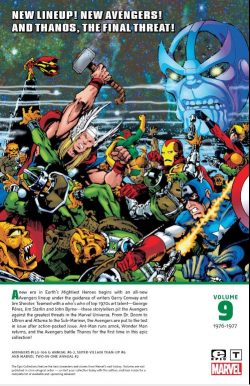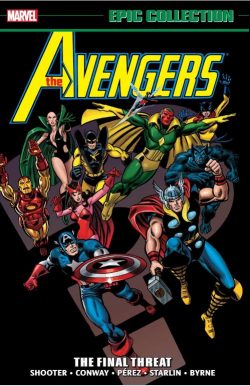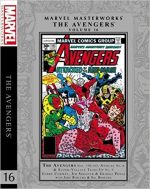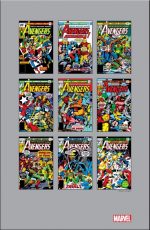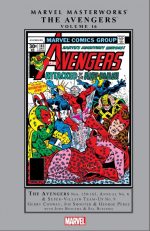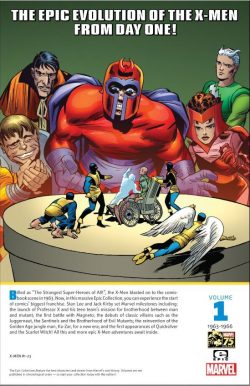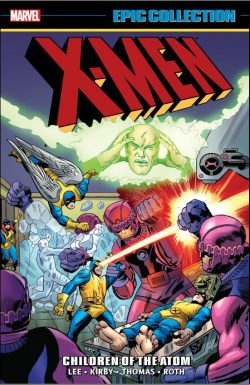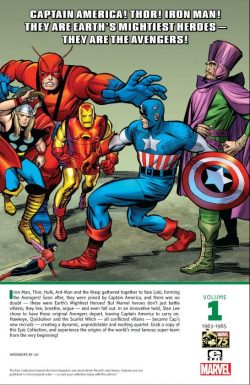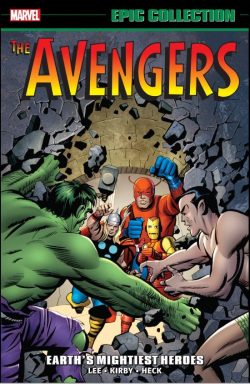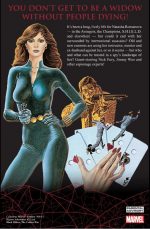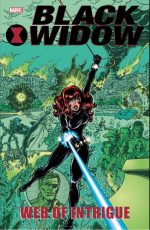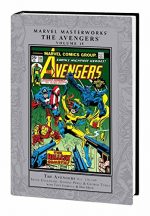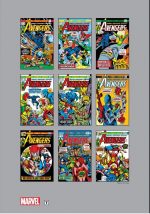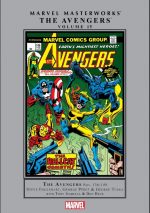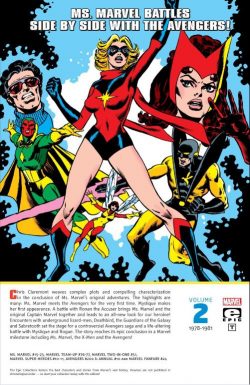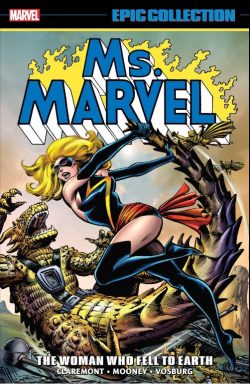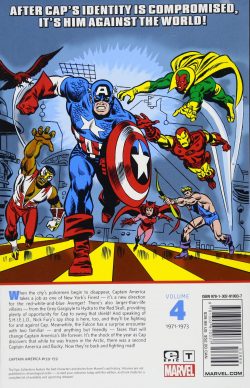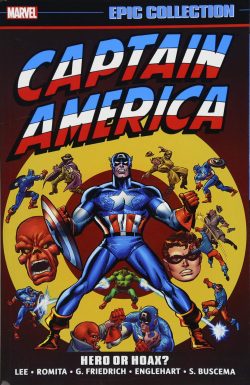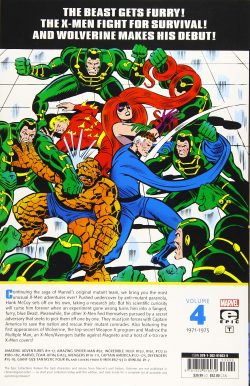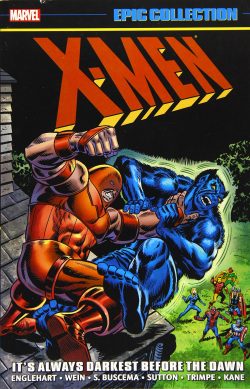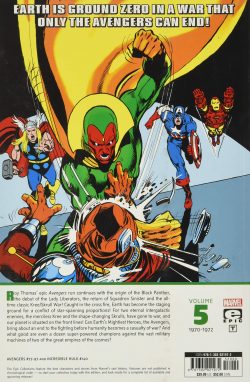
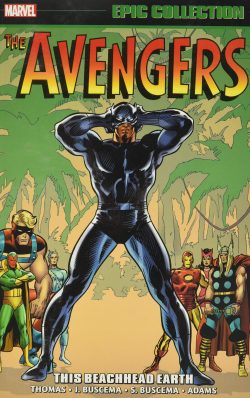
By Roy Thomas, Harlan Ellison, John Buscema, Sal Buscema, Frank Giacoia, Herb Trimpe, Sam Grainger, Neal Adams & various (Marvel)
ISBN: 978-1-3029-2197-2 (TPB)
Win’s Christmas Gift Recommendation: Matchless Blockbuster Action… 9/10
One of the most momentous events in Marvel Comics history occurred in 1963 when a disparate array of individual heroes banded together to stop the Incredible Hulk.
The Avengers combined most of the company’s fledgling superhero line in one bright, shiny and highly commercial package. Over the decades the roster has unceasingly changed, and now almost every character in their universe has at some time numbered amongst their colourful ranks…
The Avengers always proved that putting all one’s star eggs in on single basket paid off big-time; even when all Marvel’s all-stars such as Thor, Captain America and Iron Man were absent, it merely allowed the lesser lights of the team to shine more brightly.
Of course, all the founding stars regularly featured due to a rotating, open door policy which meant that most issues included one of any reader’s favourites. The increasingly bold and impressively ambitious stories and artwork were no hindrance either.
This robust trade paperback and eBook compilation gathers the astounding contents of Avengers issues #77-97, plus a crossover classic from Incredible Hulk #140, collectively spanning June 1970 – March 1972: a riot of informed social commentary and astounding cosmic calamity which confirmed scripter Roy Thomas as a major creative force in comics whilst simultaneously demonstrating the potential the “debased†medium could aspire to.
At the time Thomas’ bold experiment was rightly considered the most ambitious saga in Marvel’s brief history: astounding sagas of tremendous scope which dumped Earth into a cosmic war the likes of which comics fans had never before seen.
“The Kree/Skrull War†set the template for all multi-part crossovers and publishing events from that point onwards and was followed by more astounding epics proving that more and better was to come…
This epochal tome opens ss the tone of the times shifted and comics titles entered a period of human-scaled storytelling dubbed “Relevancy†and here – crafted by Thomas, John Buscema & Tom Palmer – a far more mundane and insidious menace manifests as billionaire financier Cornelius Van Lunt manoeuvres to bankrupt Avengers (currently Cap, Black Panther, Goliath, the Vision, Scarlet Witch and Quicksilver) sponsor Tony Stark, compelling the team to become the mystery magnate’s ‘Heroes for Hire!’
Sal Buscema then popped in to pencil ‘The Man-Ape Always Strikes Twice!’ as the embattled champions are targeted by a coterie of vengeful villains competing to join a new league of evil, spectacularly culminating in a grand clash with the aforementioned anthropoid, the Swordsman, Power Man, Living Laser and the Grim Reaper in ‘Lo! The Lethal Legion!’, which concluding chapter heralded the artistic return of Big Brother John….
Next is the debut of the company’s first Native American costumed hero in ‘The Coming of Red Wolf!’ (Thomas, John B & Palmer) wherein the Avengers are drawn into a highly personal and decidedly brutal clash between ruthless entrepreneur Cornelius Van Lunt and an Indian tribe he is defrauding and persecuting.
The dramatic dilemma divides the team and concludes with Vision, Scarlet Witch and Goliath aiding Red Wolf in concluding episode ‘When Dies A Legend!’, whilst the remaining team plus Iron Man and Thor pursue super crime combine Zodiac and the Black Panther pursues what he believes is a personal quest beside Daredevil. (This last tale occurred in DD #69 but is not included here.)
Crucially, the malevolent mega-mob move first, taking the island of Manhattan ‘Hostage!’, leaving only the solitary sightless vigilante Man Without Fear free to save the day, after which Militant Feminism raises its disconcertingly strident head as the Wasp, Black Widow, Scarlet Witch and Madame Medusa are seduced into joining a new team called the Lady Liberators (yes, I know how all that sounds now but the all-male creative team meant well…).
However, The Valkyrie who declares ‘Come on in… the Revolution’s Fine!’ has her own dark secret and sinister agenda which has nothing to do with justice or equality…
Avengers #84 features part-time paladin Black Knight who has become addicted to the bloodthirsty hunger of his Ebony Blade, resulting in an otherworldly confrontation with alternate-Earth barbarian king Arkon the Magnificent and his latest paramour the Enchantress in ‘The Sword and the Sorceress!’ The resulting acrimonious clash subsequently drops half the team in a parallel existence with no apparent way back…
In ‘The World is Not for Burning!’ (inked by Frank Giacoia), Vision, Scarlet Witch and Quicksilver’s efforts to return home leave them stranded on an Earth where the Squadron Supreme are the World’s Greatest Heroes and a solar Armageddon is only hours away…
Illustrated by Sal B & Jim Mooney, ‘Brain-Child to the Dark Tower Came…!’ sees the extremely reluctant trans-Earth allies unite to save a very different world while, back home, the Black Panther reprises his bombastic origin before taking leave of his comrades to assume the throne of his hidden African nation in ‘Look Homeward, Avenger’ (Giacoia & Sal B).
Novelist Harlan Ellison was a very vocal comics fan in the 1970s and occasionally collaborated on Marvel tales. Avengers #88 began a radical adaptation of one his best short stories, heralding ‘The Summons of Psyklop’ (Ellison & Thomas, Sal Buscema & Mooney) wherein an experiment to cure the Hulk of his destructive nature leads to the Jade Juggernaut’s abduction by a preternatural entity.
The saga concluded in Incredible Hulk #140 (Ellison & Thomas, Herb Trimpe & Sam Grainger) as ‘The Brute… That Shouted Love… at the Heart of the Atom!’ finds the man-monster experiencing true love and idyllic peace in a sub-molecular paradise, only to lose it all when the demonic Psyklop finally tracks him down…
A major turning point in Marvel history begins relatively quietly as marooned Kree warrior Captain Marvel is finally freed from imprisonment in a ghastly antimatter universe. Mar-Vell was originally sent as a spy to Earth but quickly went native to become a protector of humanity. After an intergalactic mission to save his former masters, he was flying back to Earth when suddenly sucked into the anti-matter hell of the Negative Zone…
The trapped warrior found a loophole through long-dormant Kree artefacts and Nega-bands. Inextricably bonding to professional human side-kick Rick Jones, he could switch places whenever danger loomed, but was drawn back into the dread domain after three hours.
Following interminable, agonising months when Rick refused to trade atoms with his alien alter ego, ‘The Only Good Alien…’ (#89, with art by Sal B & Grainger) sees the bonded brothers finally separate just as, in the distant Kree Empire, the ruling Supreme Intelligence is overthrown by his enforcer Ronan the Accuser…
On Earth, the rebellion results in the activation of a long-dormant robotic Kree Sentry which attacks Mar-Vell and the Avengers before enacting a deep-programmed protocol to devolve humanity to the level of Neanderthals in concluding chapter ‘Judgment Day’ (drawn and inked by “Our pal Salâ€).
Even with Ronan taking personal charge of a compromised polar base, the scheme to eradicate humanity is narrowly defeated in ‘Take One Giant Step… Backward!’, but the cat is let out of the bag about the panic-inspiring notion that extraterrestrials lurk among us. Moreover, public opinion rapidly turns against the heroes for concealing the threat of repeated alien incursions…
In a powerful allegory of the anti-Communist witch-hunts of the 1950s, the epic expands in issue #92 (Sal B & George Roussos) as ‘All Things Must End!’ reveals riots in American streets and a political demagogue capitalising on the crisis. Subpoenaed by the authorities, castigated by friends and public, Vision, Scarlet Witch and Quicksilver are ordered to disband by founding fathers Thor, Iron Man and Captain America.
Or are they…?
The plot thickens as Neal Adams & Tom Palmer assume art chores for double-sized Avengers #93 and ‘This Beachhead Earth’. Here the Vision is nigh-fatally attacked and those same founding fathers evince no knowledge of having benched the regular team.
With original Ant-Man Henry Pym undertaking ‘A Journey to the Center of the Android!’ to save the Vision’s artificial life, the Avengers become aware of not one, but two, hostile alien presences on Earth: bellicose Kree and sinister, seditious shape-shifting Skrulls. The shocking revelation triggers a ‘War of the Weirds!’ on our fragile globe.
Acting too late, the human heroes are unable to prevent mutant siblings Scarlet Witch and Quicksilver as well as their protector Mar-Vell from being abducted by the Super-Skrull…
With more stunning Adams art, ‘More than Inhuman!’ in issue #94 entangles the long-hidden race of advanced beings called Inhumans in the mix, disclosing that their advanced science and super-powers are the result of genetic meddling by the Kree in the depths of prehistory. Now, with Inhuman king Black Bolt missing and his mad, malign brother Maximus in charge, the Kree are calling in those ancient markers…
Second chapter ‘1971: A Space Odyssey’ (pencilled by John Buscema) focuses on Mar-Vell as he is increasingly pressured to reveal military secrets to his shape-shifting captors. The Skrulls are ready to launch a final devastating all-out attack on their eons-old rivals, even as on Earth ‘Behold the Mandroids!’ sees the American authorities attempting to arrest all costumed heroes…
In Avengers #95 ‘Something Inhuman This Way Comes…!’ coalesces the disparate story strands as aquatic Inhuman Triton helps defeat US government robotic Mandroids before beseeching the beleaguered heroes to find his missing monarch and rescue his people from the pressganging Kree.
After so doing, and with a solid victory under their belts at last, the Avengers head into space to liberate their kidnapped comrades and save Earth from becoming collateral damage in the impending cosmos-shaking clash between Kree and Skrulls…
‘The Andromeda Swarm!’ (with additional inking from Adams and Al Weiss) is perhaps the Avengers’ finest hour, as a small, brave band of valiant heroes hold off an immense armada of star-ships, losing one of their own in the conflict. Meanwhile the Supreme Intelligence is revealed to have been pursuing its own clandestine agenda all along, after having bewildered sidekick Rick Jones abducted to further its terrifyingly ambitious plans….
The astounding final episode ‘Godhood’s End!’ (John B & Palmer) brings the uncanny epic to a climactic close with a literal Deus ex Machina as the Supremor‘s master-plan is finally revealed. However, the war is actually ended by the most unlikely of saviours and an avalanche of costumed heroes: an action overload extravaganza which has never been surpassed in the annals of Fights ‘n’ Tights fiction…
This titanic tome is packed with extra treats, including the covers of all-reprint Avengers Annual #4 and a selection of House Ads, as well as a self-portrait of John Buscema and some of his creations. Also on view is a wealth of original art from him and Adams, plus the covers and new bridging material created by Alan Zelenetz, Walt Simonson & Palmer for the 1983 Kree-Skrull War starring the Avengers reprint miniseries and previous collection covers.
Roy Thomas and his artistic collaborators were always at the forefront of Marvel’s second generation of creators: brilliantly building on and consolidating Lee, Kirby and Ditko’s initial burst of comics creativity whilst spearheading and constructing a logical, fully functioning wonder-machine of places and events that so many others could add to.
These terrific tales are ideal examples of superheroes done exactly right and also act as pivotal points as the underdog company evolved into a corporate entertainment colossus. There are also some of the best superhero stories you’ll ever read…
© 2020 MARVEL.

